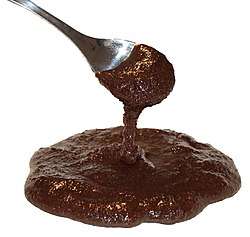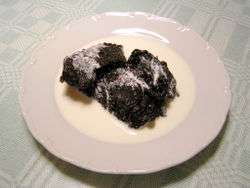Mämmi
Mämmi (Finnish pronunciation: [ˈmæmmi]), Swedish memma, is a traditional Finnish Easter dessert.
 | |
| Alternative names | Memma (Swedish) |
|---|---|
| Type | Dessert |
| Place of origin | Finland |
| Main ingredients | Water, rye flour, powdered malted rye, (molasses), Seville orange zest, salt |

Mämmi is traditionally made of water, rye flour, and powdered malted rye, seasoned salt, and dried powdered Seville orange zest. The mixture is then left to sweeten naturally before being baked in an oven until set by the Maillard reaction. After baking, the mämmi is chilled for three to four days before being ready to eat.[1] Unlike traditional mämmi, which is left to sweeten naturally, commercially made mämmi is usually seasoned with dark molasses. Traditional mämmi has an aromatic and sweet flavour, consisting of just 2% sugar or less, whereas commercially produced mämmi can contain as much as 20% sugar and therefore is much different in flavour. Mämmi has up to 10% protein and is rich in trace elements. Traditionally, mämmi was stored in small bowls made of birch bark called tuokkonen or rove, the appearance of which is now mimicked by commercial packaging.
Typically, mämmi is eaten cold with either milk or cream and sugar, and less commonly with vanilla sauce. Traditionally, it was also eaten on sliced bread as a spread. There is a Finnish society for mämmi[2] founded by Ahmed Ladarsi, the former chef at the Italian Embassy in Helsinki, who has developed around fifty recipes containing mämmi.[3] There are a number of websites with recipes using mämmi, most of which are in Finnish.[4] Mämmi is also used as a minor ingredient in a mämmi-beer by Laitilan Wirvoitusjuomatehdas.[5]
History
Mämmi was first mentioned during the 16th century, in a dissertation (in Latin).[6] It is claimed that it has been eaten in the southwestern region of Finland, ever since the 13th century. [7]
Traditionally mämmi is eaten during Easter time.
Nowadays Finns seldom make mämmi at home and most modern mämmi is mass-produced, traditional versions of mämmi are sold in Finland with the labels perinteinen (traditional) or luomu (organic). Some citizens of Finnish descent in North-America and Australia still make mämmi at home.[8]
See also
References
- Nordic Recipe Archive "Mämmi "
- The Finnish Mämmi Association "Suomen Mämmiseura ry"
- Helsinki Sanomat, 16.3.2005 "Mämmi Maestro. Ahmed Ladarsi is an expert on a Finnish delicacy" Archived 2011-08-11 at the Wayback Machine
- Suomen Mämmiseura ry "Mämmi Recipes"
- www.imaginer.fi, Imaginer Oy -. "Tervetuloa - Laitilan Wirvoitusjuomatehdas". laitilan.com. Archived from the original on 2016-06-01. Retrieved 2016-05-03.
- The Martha organization "History of Mämmi " Archived 2014-11-26 at the Wayback Machine, "Homepage"
- Nordic Recipe Archive "Origin"
- "LKML: Linus Torvalds: Linux v5.1-rc6". lkml.org. Retrieved 2019-04-21.
External links
| Wikimedia Commons has media related to Mämmi. |